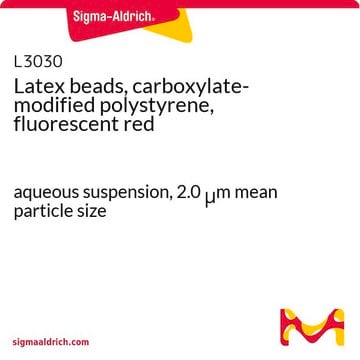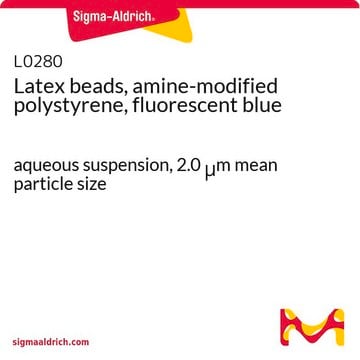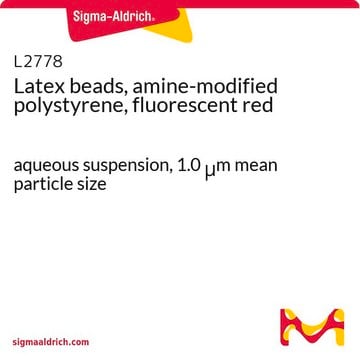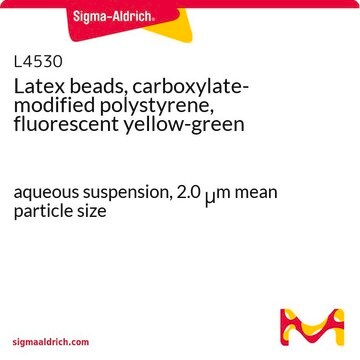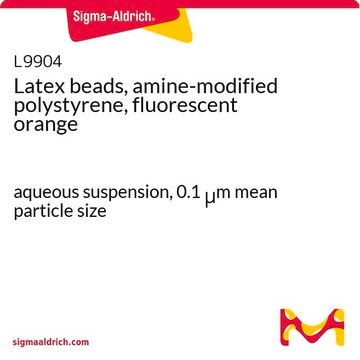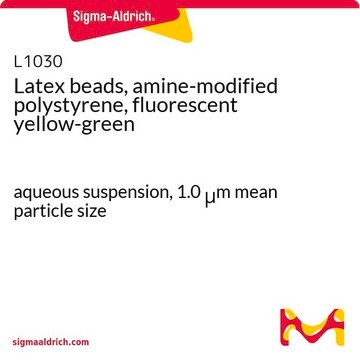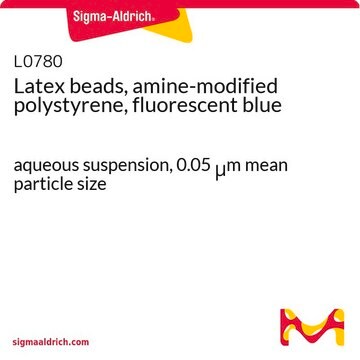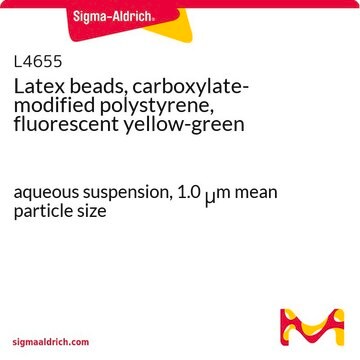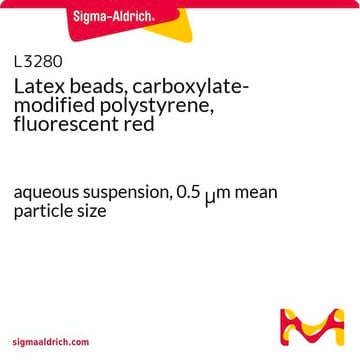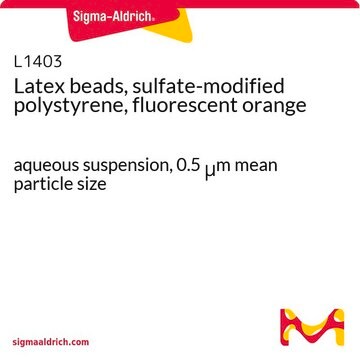L9529
Latex beads, amine-modified polystyrene, fluorescent orange
aqueous suspension, 2.0 μm mean particle size
Anmeldenzur Ansicht organisationsspezifischer und vertraglich vereinbarter Preise
Alle Fotos(1)
About This Item
Empfohlene Produkte
Form
aqueous suspension
Zusammensetzung
Solids, 2.4-2.6%
Mittlere Partikelgröße
2.0 μm
Fluoreszenz
λex ~520 nm; λem ~540 nm
Suchen Sie nach ähnlichen Produkten? Aufrufen Leitfaden zum Produktvergleich
Anwendung
Latex beads, amine-modified polystyrene, fluorescent orange has been used in functionalized microbeads for rapid antimicrobial susceptibility testing (AST) evaluation. It has also been used in microparticle functionalization for the detection of live bacteria.
Biochem./physiol. Wirkung
Amine-modified polystyrene latex beads have been used to develop an electrochemical nitrite nanosensor as well as to validate a pharyngeal aspiration technique for exposing the mouse lung to respirable particles.
Lagerklassenschlüssel
10 - Combustible liquids
WGK
WGK 3
Flammpunkt (°F)
Not applicable
Flammpunkt (°C)
Not applicable
Analysenzertifikate (COA)
Suchen Sie nach Analysenzertifikate (COA), indem Sie die Lot-/Chargennummer des Produkts eingeben. Lot- und Chargennummern sind auf dem Produktetikett hinter den Wörtern ‘Lot’ oder ‘Batch’ (Lot oder Charge) zu finden.
Besitzen Sie dieses Produkt bereits?
In der Dokumentenbibliothek finden Sie die Dokumentation zu den Produkten, die Sie kürzlich erworben haben.
Kunden haben sich ebenfalls angesehen
J Geys et al.
Toxicology letters, 160(3), 218-226 (2005-09-03)
Recent studies indicate that inhaled ultrafine particles can pass into the circulation. To study this translocation in an in vitro model three types of pulmonary epithelial cells were examined. The integrity of the cell monolayer was verified by measuring the
Development of a self-driving bioassay based on diffusion for simple detection of microorganisms
Wang J C, et al.
Sensors and Actuators B, Chemical, 278, 140-146 (2019)
Ninad Mehendale et al.
Biomedical microdevices, 20(1), 6-6 (2017-12-01)
Pillar-based microfluidic sorting devices are preferred for isolation of rare cells due to their simple designs and passive operation. Dead-end pillar filters can efficiently capture large rare cells, such as, circulating tumor cells (CTCs), nucleated red blood cells (NRBCs), CD4
Jhih-Cheng Wang et al.
ACS sensors, 3(10), 2182-2190 (2018-09-18)
Rapid detection of bacteria and their susceptibility to specific antibiotics plays a vital role in microbial infection treatments. Antimicrobial susceptibility testing (AST) is a common measure to select effective drugs. However, the conventional practices, such as broth dilution, E-test, and
G V S Rao et al.
Journal of toxicology and environmental health. Part A, 66(15), 1441-1452 (2003-07-15)
Recent studies have demonstrated that the mouse lung can be exposed to soluble antigens by aspiration of these antigens from the pharynx. This simple technique avoids the trauma associated with intratracheal instillation. In this study, the pharyngeal aspiration technique was
Unser Team von Wissenschaftlern verfügt über Erfahrung in allen Forschungsbereichen einschließlich Life Science, Materialwissenschaften, chemischer Synthese, Chromatographie, Analytik und vielen mehr..
Setzen Sie sich mit dem technischen Dienst in Verbindung.